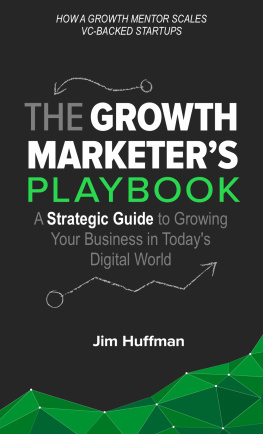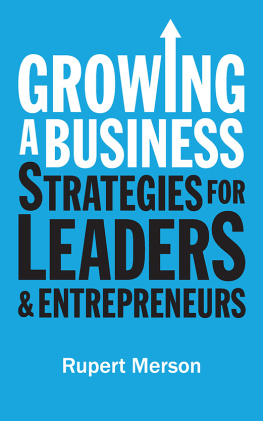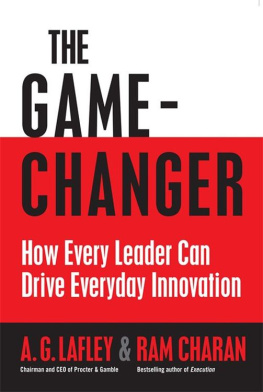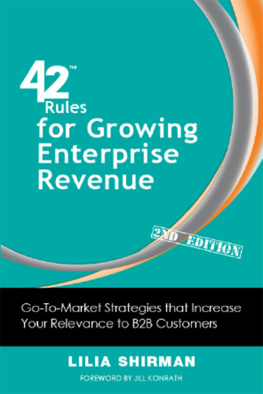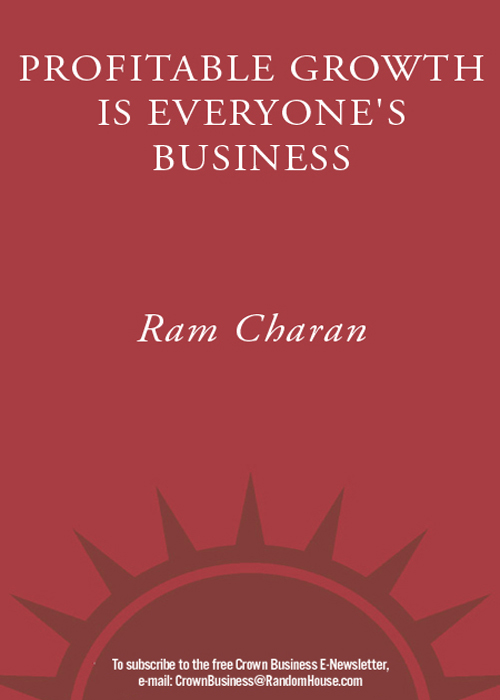
Contents
Profitable Growth Is Everyones Business
10 Tools You Can Use Monday Morning
Ram Charan

Dedicated to the hearts and souls of the joint family of twelve siblings and cousins living under one roof for fifty years, whose personal sacrifices made my formal education possible.
Introduction
How to Get More Out of What You Already Have
P ROFITABLE GROWTH IS EVERYONES BUSINESS is based on living research. For the past twenty-five years I have, on a daily basis, been observing what is happeningwhat is working and what isntwhile it is actually happening in companies around the world.
My experiences with many of these companies have been long terma decade or more in many casesand the ideas I have developed for solving the growth dilemma are based on personally seeing what works in real time.
These are ideas tested across industries and that deliver results. My goal has always been to improve the practice of business by giving people tools they can put to use immediately, on Monday morning, if you will. These tools can seem like common sense, but all too often the biggest challenge in business is the translation of ideas into action. This is especially true when it comes to obtaining consistent revenue growth. The ultimate purpose of Profitable Growth Is Everyones Business is to provide the tools for people in every industry concerned about the prospect of generating sustained, internally generated top-line growth. Many people feel that their base business is being eroded by such factors as the lack of pricing power, excess capacity (too many suppliers chasing too few customers), and global competition. They are also seeing that cost-cutting and productivity improvements alone will not be enough to generate the kind of performance that will satisfy either shareholders, or, more important, the employees whose prospects depend on revenue growth generating future career opportunities. And, eventually, lack of growth makes a business uncompetitive in the eyes of customers, since without sustained revenue growth, the ability to innovate declines and a company goes into a death spiral.
Many people equate growth within the language of baseballswinging for the fences, home runs that capture huge sales increases that will dramatically increase the size of their business. Growth is too often thought of only in big-dollar terms, breakthroughs such as the creation of a new business model, the development of a breakthrough product, the mega-merger, or a world-changing new technology. When it comes to growth, managers often think they have to break the paradigm; they say such things as, If I cant get a double-digit gain by next year, its not worth the effort. Its all or nothing. A single or double just doesnt seem good enough.
I have talked to literally hundreds of managers over the past few years who believe this, and they all are frustrated. They are struggling to come up with the big ideas, and far too often, to extend the baseball metaphor, they swing and miss. Or worse, they dont even swing, failing to fund new ideas because of the perception that the risk is too great.
As I probed deeper into the problem, what I began to see is that managers in many companies do not have as effective a handle as they should on the building blocks for growth and the linkages between them.
In many cases these building blocks, such as development of new products and services, an effective sales force, finding ways to understand what the customer values, and segmenting markets, have been neglected and given inadequate resources. They are, in fact, not even on the radar screen of senior management to the same degree as cost reduction has been. Imagine what would happen if the same focus was given to sources of revenue growth as has been given to programs such as Six Sigma, centralized purchasing, and moving production facilities to low-cost countries to achieve global cost parity.
To get people to take a fresh look at the fundamentals and their importance for sustained revenue growth, I would, in one-on-one meetings, askon a scale of one to tenquestions like:
What are you doing to help your customers prosper?
What is the quality of your sales force in shaping and customizing a unique value proposition for your customer?
How effectively is your pricing tied to the attributes the customer most highly values?
In every interaction with a customer, how well do your people extract information about customer needs? Are they relaying the information to the people who can act on it, the departments that can develop products and services to satisfy those needs?
More often than not, when I ask these questions, the answer is on the lower end of the scalea two, three, or four. Then the lightbulb comes on and what people begin to realize is that we have met the enemy and they are us, that the answer to growth is not some silver bullet but lies within the business. They come to understand that they are missing the obvious. Theres a deep sigh of relief when they come to realize that revenue growth is within their reach. In other words, what is missing is attention to the way the fundamentals of the business have to link to each other to make growth happen. Here we are going to supply that missing link. This is not a book about shifting your strategy or changing your business model, but how you can accelerate the revenue growth of your current business.
It often comes as a revelation to many of the people I work with that revenue growth is not just the domain of the specialiststhe sales force or those in charge of product development, for example. Growth is everyones business. Just as in baseball, where everyone on the team has the potential ability to hit a single or a double, in business, everyoneand that can run the gamut from the CEO to the marketing and sales people on the front end to those who have operations and service jobs on the back endhas an opportunity to increase revenues. And, in fact, people who dont occupy the executive suite have a big vested interest in doing so. Without growth, personal opportunity is a zero-sum game, that is, for me to win, someone else in the company (usually) has to lose. With growth, the organization expands and people can build a career and a future with a company they have faith in.
In the pages ahead, I am going to show you that you can follow a more effective growth process, one based on singles and doubles that will cumulatively over time enable you to increase your revenues substantially.
Singles and doubles are based on improvements or natural extensions of a businesss strategy, business model, or technology. They can come from both relatively small day-to-day wins as well as adaptation to major changes in the marketplace. I am going to put this idea into context as well as provide tools that you can employ to increase your revenues and grow faster than the economy as a whole, no matter what business you are in. There are companies whose strategy is at a crossroads. Sun and Motorola are two examples. And there are industries, such as the music business, in which the current business model is obsolete. Even in these cases, singles and doubles provide the foundation for making the necessary change.
How you can make those changes is what this book is all about. Chapter 2 provides the reorientation from waiting for home runs to showing how to set realistic goals that you can achieve through singles and doubles and by making revenue growth everyones business. Chapter 3 shows how to distinguish good growthgrowth that is organic, profitable, differentiated, sustainablefrom bad growth. Chapter 4 looks at how to dispel the myths and beliefs that inhibit organizations from growth.
Next page

